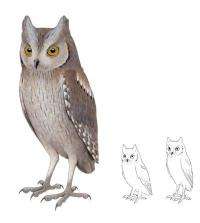An extinct species of scops owl has been discovered in Madeira

An international team of scientists, including some from Majorca and the Canary Islands, have described a new type of fossil scops owl, the first extinct bird on the archipelago of Madeira (Portugal). Otus mauli, which was also the first nocturnal bird of prey described in the area, lived on land and became extinct as a result of humans arriving on the island.
Twenty years ago, the German researcher Harald Pieper discovered fossil remains of a small nocturnal bird of prey in Madeira, which, until now, had not been studied in depth. The international team of palaeontologists has shown that the remains belong to a previously unknown extinct species of scops owl, which they have called Otus mauli.
"It has long legs and wings slightly shorter than the continental European scops owl from which it derives" Josep Antoni Alcover, one of the authors of the study and researcher at the Mediterranean Institute for Advanced Studies (IMEDEA), a mixed centre of the university of the Balearic Islands and the Spanish National Research Council (CSIC), told SINC.
The result of the analysis of the proportions of the remains found, which has been published in the journal Zootaxa, reveals that Otus mauli could be a land inhabiting species that ate invertebrates and "occasionally lizards or birds".
"It is likely that their extinction is linked to the arrival of humans and the fauna they brought with them", Alcover explains. He also points out that their disappearance formed part of a pattern of extinction of the island's species, which occurred in virtually all the islands of the world.
According to researchers, amongst the causes of extinction of this scops owl, the destruction of its habitat is highlighted, as Madeira had a lot of serious fires during the seven years that followed the Portuguese arrival. Furthermore, humans brought new birds with diseases that were unfamiliar to the native species, as well as rats and mice that could prey on eggs of animals that had nests close to the ground.
Exclusive to Madeira?
The same or a similar species has been investigated in Porto Santo, another island of the archipelago of Madeira. "This is extremely interesting" the researcher says, "but difficult to assess because the materials found are limited and fragmented".
"If the scops owls of Madeira and Porto Santo were different species, it would mean that the Otus' flying ability is much more limited than continental scops owls. The distance between the two islands would be enough to isolate them" Alcover points out.
The homogeneity of the scops owls' measurements on the two islands, as well as the differences compared to European scops owls suggests that they were genetically isolated from the European populations. The distance between the continent and the island was enough to explain the difference in the species.
On this island they expect to discover new species of birds in the near future "which will report a world that disappeared just a few hundred years ago". "The same thing will happen in the Azores islands where there is already evidence that a scops owl different to the ones in Madeira and Europe that is also extinct" the scientist says.
More information: Rando J.C.; Pieper H.; Alcover J.A.; Olson S.L. "A new species of extinct fossil Scops owl (Aves: Strigiformes: Strigidae: Otus) from the Archipelago of Madeira (North Atlantic Ocean)". Zootaxa 3182: 29-42, Feb 2012.
Journal information: Zootaxa
Provided by FECYT - Spanish Foundation for Science and Technology

















